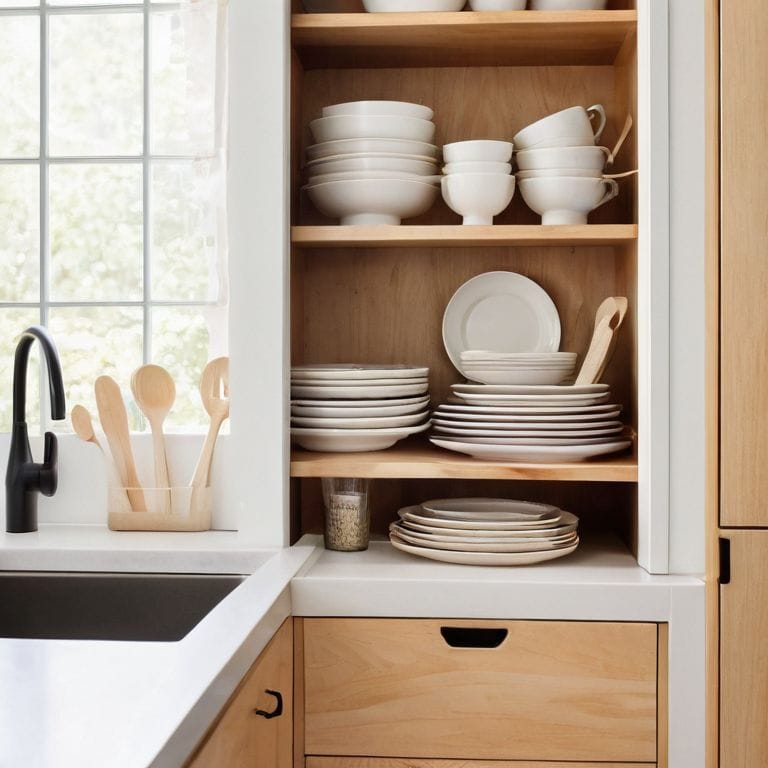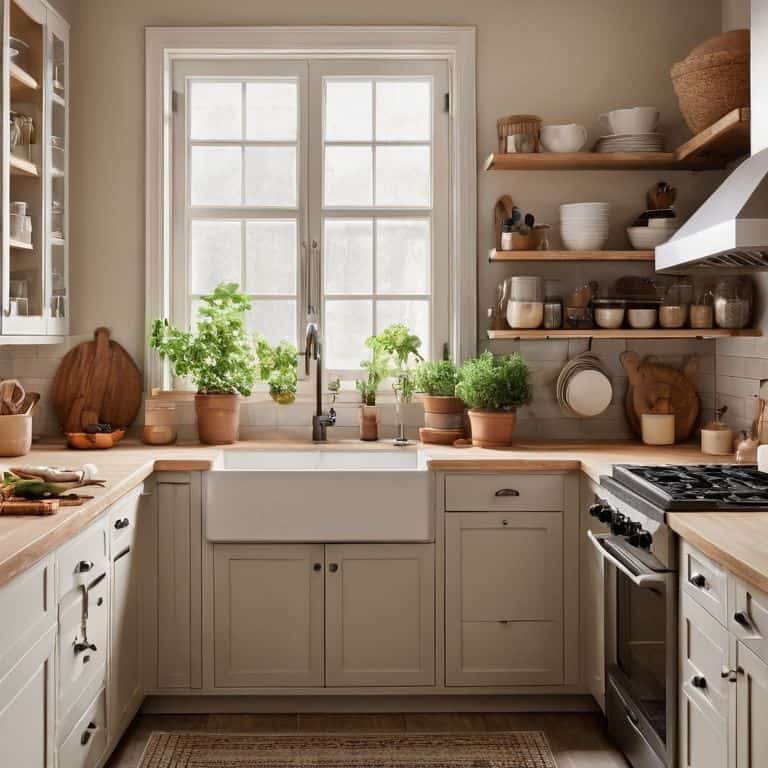I still remember the moment I realized that how to organize kitchen cabinets wasn’t just about stuffing everything into a tidy box. I was in my own kitchen, struggling to find the right utensils for a dinner party, and I felt like I was drowning in a sea of _cluttered chaos_. It was then that I discovered the power of intentional design and organization. By applying simple, yet effective principles, I transformed my kitchen into a haven of efficiency and elegance. Now, I’m passionate about sharing my knowledge with others, to help them achieve the same sense of kitchen harmony.
In this article, I’ll cut through the noise and share my honest, no-hype advice on how to organize kitchen cabinets. You’ll learn how to _maximize your storage_, create a functional workflow, and maintain a sense of style that reflects your personal taste. Whether you’re a busy home cook or an avid entertainer, I’ll provide you with practical tips and inspiration to help you create a kitchen that truly works for you. From _optimizing your shelf space_ to selecting the perfect cabinet accessories, I’ll cover it all. So, let’s get started on this journey to kitchen bliss, and discover how a well-organized kitchen can be the foundation of a happy, stress-free home.
Table of Contents
Guide Overview: What You'll Need

Total Time: 2 hours 30 minutes
Estimated Cost: $50 – $100
Difficulty Level: Intermediate
Tools Required
- Measuring Tape (for accurate shelf measurement)
- Level (to ensure even installation)
- Screwdriver (for assembling storage units)
- Drill (for making holes for shelves or baskets)
- Utility Knife (with extra blades for cutting adhesive-backed liners)
Supplies & Materials
- Stackable Containers (for storing food or kitchen items)
- Adhesive-Backed Liners (for lining shelves and drawers)
- Adjustable Shelves (for customizing cabinet space)
- Drawer Dividers (for organizing utensils and kitchen tools)
- Over-the-Door Storage Racks (for hanging items like spices or cleaning supplies)
Step-by-Step Instructions
- 1. First, let’s start by purging unwanted items from your kitchen cabinets. Take everything out and sort items into three piles: keep, donate/sell, and discard. Be honest with yourself about each item – when was the last time you used it? Is it still in good condition? This will help you decide what to keep and what to let go of.
- 2. Next, _categorize your kitchen items_ into groups, such as baking supplies, cooking utensils, and dinnerware. This will make it easier to decide which items to store together and where. Think about the kitchen work triangle and how you can group items in a way that minimizes walking distance and maximizes efficiency.
- 3. Now, let’s focus on _assigning a home_ for each group of items. Consider the frequency of use and the best location for each group. For example, your most frequently used cooking utensils should be stored in an easy-to-reach location, such as a drawer or a hook near your cooking station. Less frequently used items, like special occasion dishes, can be stored in higher or harder-to-reach cabinets.
- 4. It’s time to optimize your cabinet storage. Use dividers, baskets, or other organizational tools to separate items within each cabinet and keep them organized. For example, you can use a divider to separate your baking supplies from your cooking spices, or a basket to store small items like coffee filters or tea bags.
- 5. To make the most of your cabinet space, consider _installing shelves or drawers_ that are adjustable. This will allow you to customize the storage to fit your specific needs and items. You can also use stackable containers to store items like flour, sugar, or pasta, keeping them fresh and organized.
- 6. Let’s not forget about the _back of the cabinet door_ – this is a great place to store items like spice racks, utensils, or cleaning supplies. Use over-the-door storage racks or hooks to maximize this often-wasted space and keep your cabinets clutter-free.
- 7. Finally, _maintain your newly organized cabinets_ by scheduling regular clean-outs and re-organizing sessions. Set a reminder to go through your cabinets every few months to get rid of any new items that are no longer needed and to re-adjust your storage as needed. This will help keep your kitchen running smoothly and ensure that your cabinets remain a haven of organization.
Taming Kitchen Cabinet Chaos

As I always say, a well-organized kitchen is the heart of a happy home. To achieve this, it’s essential to focus on maximizing kitchen storage space. One of my favorite tips is to utilize the often-wasted space on the back of kitchen cabinet doors. By installing a few simple hooks or a pegboard, you can hang items like utensils, oven mitts, or even spices, keeping them within easy reach while freeing up valuable shelf space.
When it comes to customizing your cabinet organization, consider implementing diy kitchen cabinet dividers. These can be as simple as wooden or plastic inserts that separate items within a cabinet, or as complex as a fully customized system. The key is to create a system that works for you and your unique cooking style. For example, if you’re a avid baker, you may want to dedicate an entire cabinet to baking supplies, using kitchen cabinet shelving ideas to optimize the space.
In my experience, the most significant impact on kitchen workflow comes from optimizing kitchen workflow. By grouping similar items together and placing them in easy-to-access locations, you can streamline your cooking process and reduce stress. For instance, storing all your cooking oils and spices near the stove can save you time and effort in the long run. By implementing these simple yet effective strategies, you’ll be well on your way to creating a kitchen that is both beautiful and functional.
Diy Dividers for Optimized Workflow
To create a seamless workflow, I swear by DIY dividers. These simple additions can make a world of difference in maintaining your kitchen’s harmony. By separating utensils, spices, or baking supplies, you’ll avoid clutter and save time searching for what you need. I like to use wooden or acrylic dividers, which can be easily cut to size and placed within your cabinets.
For a more polished look, consider adding labels to your dividers. This will help you quickly identify what’s behind each divider, making meal prep a breeze. Plus, it’s a great way to add a personal touch to your kitchen. With DIY dividers, you can achieve a customized storage system without breaking the bank. Give it a try and watch your kitchen transform into a haven of efficiency and elegance.
Maximizing Storage With Custom Systems
To take your kitchen cabinet organization to the next level, consider investing in custom storage systems. These can be tailored to fit your specific needs, making the most of often-wasted spaces like corners or narrow shelves. For me, there’s nothing quite like the thrill of discovering a cleverly designed pull-out drawer or a rotating carousel that turns a cluttered mess into a tidy haven. By incorporating custom systems, you can create a kitchen that not only looks beautiful but also functions like a well-oiled machine, making cooking and entertaining a pure joy.
5 Essential Tips to Unlock Your Kitchen's Full Potential
- Start by purging your kitchen cabinets of any unnecessary or redundant items, and consider donating gently used dishes, pots, and pans to a local charity
- Implement a ‘zone’ organization system, where similar items are grouped together, such as baking supplies, cooking utensils, and dinnerware
- Utilize the often-wasted space on the back of cabinet doors by installing adhesive hooks, spice racks, or a pegboard for hanging frequently used items
- Optimize your cabinet shelves by using stackable containers, baskets, or drawers to store dry goods, snacks, and other non-perishable items, keeping them fresh and easily accessible
- Invest in a few versatile, adjustable dividers to separate large cabinets into smaller, more manageable sections, making it easier to find what you need when you need it
Key Takeaways for a Harmonious Kitchen
By applying the principles of the ‘kitchen work triangle’, you can significantly reduce cooking time and effort, making meal prep a breeze
Investing in custom storage systems or creating DIY dividers can help maximize your cabinet space, keeping your kitchen clutter-free and your mind clear
Remember, the perfect kitchen is all about balance – striking a chord between aesthetics, functionality, and workflow to create a space that inspires you to cook, create, and connect with loved ones
The Heart of Kitchen Harmony
A well-organized kitchen cabinet is not just a storage solution, it’s a reflection of your cooking soul – it’s where function meets inspiration, and every dish begins with a sense of clarity and joy.
Clara Wu
Bringing Harmony to Your Kitchen

As we’ve explored the world of kitchen cabinet organization, I hope you’ve seen how a few simple steps can lead to a more serene and efficient cooking space. From maximizing storage with custom systems to creating DIY dividers for an optimized workflow, it’s all about finding that perfect balance between form and function. By applying the kitchen work triangle principle and giving your pantry a thoughtful makeover, you’re not just organizing cabinets – you’re crafting a space that inspires better cooking and warmer moments with loved ones.
So, as you stand in your newly organized kitchen, feeling the joy of a job well done, remember that the true magic happens not just in the organization, but in the beautiful moments you create there. Whether it’s a quiet morning with coffee or a bustling dinner party, your kitchen is more than just a space – it’s the heart of your home, waiting to be filled with love, laughter, and the simple pleasures of life.
Frequently Asked Questions
What are some creative ways to use the space on the back of a cabinet door?
One of my favorite hacks is to use the back of a cabinet door as extra storage. You can add a pegboard for hanging utensils, a spice rack, or even a magnetic strip for spices or oils. It’s amazing how much more efficient your kitchen can be with just a little extra planning!
How can I determine the best shelf height for my kitchen cabinets to maximize storage and accessibility?
To determine the best shelf height, consider your cooking habits and the items you use most. For me, it’s all about the kitchen work triangle. I like to store heavy items, like pots and pans, near the floor, and lighter items, like spices and oils, at eye level. Experiment with different heights and see what feels most intuitive for you.
What types of dividers or inserts are best for organizing pots, pans, and cooking utensils in a crowded cabinet?
For pots, pans, and cooking utensils, I swear by adjustable dividers and tray inserts. They help separate items by size and type, making them easy to find and access. You can also use pegboards or hooks for hanging utensils, keeping them organized and out of the way. It’s all about creating a system that works for you!
